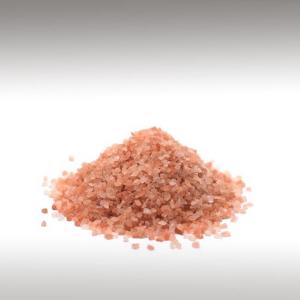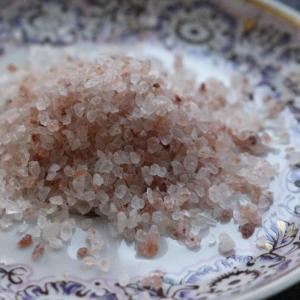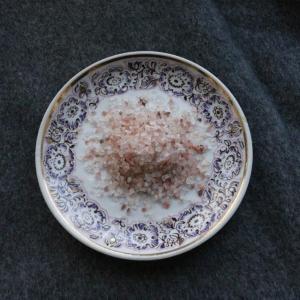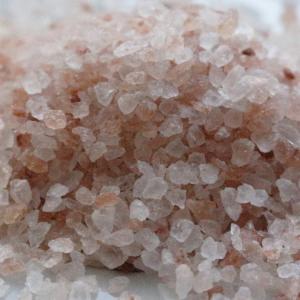
HIMALAYAN PINK SALT - INGREDIENTS

BASE / GENERAL DATA
Information submited: November 5, 2017 Modified: May 30, 2018 By: OperaDreamhouse
Himalayan Salt is chemically similar to Table Salt plus mineral impurities like chromium, iron, zinc, lead, and copper. Pink Himalayan Salt is often said to be the most beneficial as well as the cleanest Salt available on this planet today.
Some Salt crystals from the Himalayas have an off-white to transparent color, while impurities in some veins of Salt give it a pink, reddish, or beet-red color.
The concentration of salt near Khewra, Punjab is said to have been discovered around 326 BC when the troops led by Alexander the Great stopped to rest there and noticed their horses licking the salty rocks. Salt was probably mined there from that time, but the first records of mining are from the Janjua people in the 1200s.
Himalayan Salt is mostly mined at the Khewra Salt Mine in Khewra, Jhelum District, Punjab, which is situated in the foothills of the Salt Range hill system in the Punjab province of the Pakistan Indo-Gangetic Plain.
Some Salt crystals from the Himalayas have an off-white to transparent color, while impurities in some veins of Salt give it a pink, reddish, or beet-red color.
The concentration of salt near Khewra, Punjab is said to have been discovered around 326 BC when the troops led by Alexander the Great stopped to rest there and noticed their horses licking the salty rocks. Salt was probably mined there from that time, but the first records of mining are from the Janjua people in the 1200s.
Himalayan Salt is mostly mined at the Khewra Salt Mine in Khewra, Jhelum District, Punjab, which is situated in the foothills of the Salt Range hill system in the Punjab province of the Pakistan Indo-Gangetic Plain.
Pink Himalayan Salt is a truly unique salt. It’s also referred to as Pink Salt, Himalayan Sea Salt, Rock Salt and Himalayan Crystal Salt.
This salt is classified as Rock Salt or Halite, which comes from the Punjab region of Pakistan about 190 miles from the Himalayas. This region has one of the richest salt fields in the entire world, and they are very old. With a history dating back to Earth’s creation, Himalayan Salt is believed to be composed of dried remnants of the original, primal sea.
Himalayan Crystal Salt comes from salt mines 5,000 feet deep below the Himalayan Mountain Range. The salt from these mines has experienced tremendous pressure over millions of years and is said to be over 99% pure.
This salt is classified as Rock Salt or Halite, which comes from the Punjab region of Pakistan about 190 miles from the Himalayas. This region has one of the richest salt fields in the entire world, and they are very old. With a history dating back to Earth’s creation, Himalayan Salt is believed to be composed of dried remnants of the original, primal sea.
Himalayan Crystal Salt comes from salt mines 5,000 feet deep below the Himalayan Mountain Range. The salt from these mines has experienced tremendous pressure over millions of years and is said to be over 99% pure.

SPIRITUAL PRACTISES DATA

MEDICINE / HEALTH DATA
Information submited: November 5, 2017 Modified: May 30, 2018 By: OperaDreamhouse
Therapeutic properties:
Aids in vascular health;
Supports healthy lungs and respiratory function;
Promotes a stable pH balance within the cells;
Reduces the signs of aging;
Promotes healthy sleep patterns;
Increases libido;
Prevents muscle cramps;
Increases hydration;
Strengthen bones;
Lowers blood pressure;
Improves circulation;
Detoxifies the body of heavy metals;
Contract and relax muscles;
Maintain proper fluid balance and prevent dehydration;
Send nervous system impulses;
Prevent low blood pressure.
Supports healthy lungs and respiratory function;
Promotes a stable pH balance within the cells;
Reduces the signs of aging;
Promotes healthy sleep patterns;
Increases libido;
Prevents muscle cramps;
Increases hydration;
Strengthen bones;
Lowers blood pressure;
Improves circulation;
Detoxifies the body of heavy metals;
Contract and relax muscles;
Maintain proper fluid balance and prevent dehydration;
Send nervous system impulses;
Prevent low blood pressure.
Pink Himalayan Salt is a much more balanced and healthy choice in comparison to common Table Salt. True, high-quality Pink Himalayan Salt is one of the purest salts you can find.
Table Salt is very heavily processed, eliminating its minerals. Commercial table salt is typically 97.5 % to 99.9% Sodium Chloride. Meanwhile, a high-quality unrefined salt like Himalayan Sea Salt is only about 87 percent Sodium Chloride.
Himalayan Salt contains the same 60 - 84 trace minerals and elements that are found in the human body, a few of which include Sodium Chloride, sulphate, calcium, potassium, and magnesium. When consuming this salt, you are actually getting less Sodium intake per serving than regular Table Salt because it is less refined and the pieces are larger.
Another great thing about this Salt is that, because of its unique cellular structure, it stores vibrational energy. The minerals in this salt exist in colloidal form, which means that they are small enough for our cells to absorb easily.
According tothe Lung Institute, Salt is antibacterial, anti-inflammatory, loosens excessive mucus and speeds up mucus clearance, removes pathogens in the air like pollen, and decreases immune system oversensitivity level.
Halotherapy or Salt therapy is the inhalation of micronized dry Salt within a chamber that mimics a salt cave. Studies have shown halotherapy to be a highly effective drug-free part of successfully treating chronic bronchitis.
Salt in excess amounts may even contribute to autoimmune diseases, as it overstimulates the immune system. Examples of autoimmune diseases include multiple sclerosis, rheumatoid arthritis, lupus, and psoriasis.
Pink Himalayan Sea Salt’s rich mineral content can help balance your body’s pH levels. A proper pH helps foster your immunity and encourage good digestion. Since Pink Himalayan Salt contains Sodium as well as other electrolytes, it has a direct effect on the pH of your blood.
Halotherapy or Salt therapy is the inhalation of micronized dry Salt within a chamber that mimics a salt cave. Studies have shown halotherapy to be a highly effective drug-free part of successfully treating chronic bronchitis.
Salt in excess amounts may even contribute to autoimmune diseases, as it overstimulates the immune system. Examples of autoimmune diseases include multiple sclerosis, rheumatoid arthritis, lupus, and psoriasis.
Pink Himalayan Sea Salt’s rich mineral content can help balance your body’s pH levels. A proper pH helps foster your immunity and encourage good digestion. Since Pink Himalayan Salt contains Sodium as well as other electrolytes, it has a direct effect on the pH of your blood.

BEAUTY / COSMETICS DATA

FOOD / COOKING DATA
Information submited: November 5, 2017 Modified: May 30, 2018 By: OperaDreamhouse
This type of Salt is used in the same manner as common Table Salt - in cooking, to season meals, and to preserve food.
Always use pre-ground Salt or grinders like any other kind of Salt. Salt slabs will impart a better taste and mineral content.
Himalayan Salt is also naturally anti-microbial, so cleanup requires only a simple scrub or rinse.
Himalayan Salt is also naturally anti-microbial, so cleanup requires only a simple scrub or rinse.
Adding a pinch of Pink Salt to meals or drinks is believed to help the body achieve optimal fluid balance, thus preventing dehydration.
It is true that Sodium is necessary to maintain proper fluid balance, although this is true for sodium from other sources, and not just from Pink Himalayan Salt.
It is true that Sodium is necessary to maintain proper fluid balance, although this is true for sodium from other sources, and not just from Pink Himalayan Salt.
COMMENTS
No comments.





